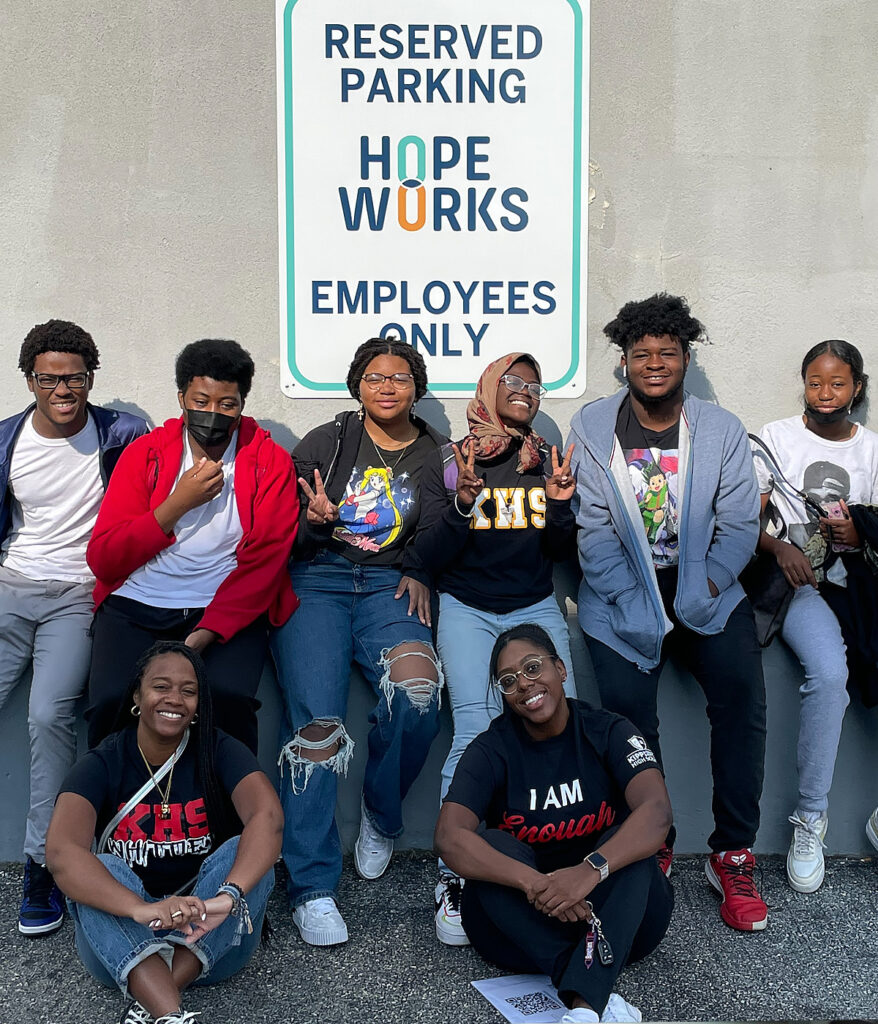This case study tells the story of how an employment social enterprise (ESE) defined goals, selected venture criteria, and used them to identify the ideal city to expand to. The Venture Criteria Bank Tool provides a practical resource to apply lessons from this case study.
Define Your Goals: Bringing Opportunity to More Youth
Founded in Camden in 1999, Hopeworks uses technology, healing, and entrepreneurship to propel opportunity youth to build strong futures and break the cycle of violence and poverty. Youth working at Hopeworks learn to code, design, and develop websites, and they grow those skills by working with enterprising businesses in the community. On average, youth (aged 17-26) entering Hopeworks make $415 annually. Youth completing the Hopeworks program make, on average, over $40,000 annually, with an almost 90% 12-month retention rate in their jobs.
Having established a proven model in Camden, Hopeworks set an ambitious goal to place 500 full-time employees annually by 2025. This goal is aligned to their organizational mission: with a focus on skill development, real-world job experience, and trauma-informed care, Hopeworks propels young adults into long-term living wage careers that put them on the path for healing and financial stability.
To determine how to achieve this goal, Hopeworks conducted two sets of analyses. First, they looked at how many youth they could serve in their current geography, Camden, through a pipeline analysis. Using existing data on conversion rates from target population to full-time employees who graduate from their program, they projected that their Camden location could only enable them to reach ~275 more youth. Further, they analyzed other ESE models and found that none employs 500 people at only one site. To achieve their mission-aligned goal, Hopeworks concluded they would need to open a new site beyond their current market.

Select & Use Venture Criteria: Selecting A New Site
Equipped with a clear goal and data-driven rationale for why expanding made sense for them, Hopeworks began the process of determining an expansion site. Given there are many potential options, Hopeworks needed to quickly narrow down the list to a manageable number of sites they could analyze in greater depth. They picked two criteria core to their ESE model, to help them filter their options down to 15 cities: 1) high poverty rates and 2) proximate to Fortune 500 companies, who could serve as placement employers.
To determine which of the 15 cities would be most well-placed for them to achieve their goal, they developed a set of venture criteria. Venture criteria are predefined conditions that outline the requirements that must be met for an ESE venture to be successful.
There are three types of criteria ESEs can consider:
- Social: does this venture align with the social impact goals of your ESE?
- Operational: can your ESE support the operational requirements of this venture?
- Financial: is this venture financially viable for your ESE?
Hopeworks collaborated with key internal and external stakeholders to select up to 12 venture criteria to help them evaluate which city most aligned to their mission and goals, and was most feasible. About 80% of these criteria are likely to apply to many other ESE ventures (e.g., open jobs in your industry, demonstrated customer base, access to transportation system), but 20% are unique to Hopeworks (e.g., tech training ecosystem). ESEs can use REDF’s Venture Criteria Bank Tool to select, refine, and use their own venture criteria.
| Venture Criteria Type | Definition | Target | Priority |
|---|---|---|---|
| Social | |||
| Demographics: annual unemployment rates (city) | Unemployment percentage in city, calculated by taking the monthly UE averages for time period: 2021 YTD | The average of monthly unemployment rates for the time period identified in MSA is over 6.1%, the national rate of unemployment over the past 6 months. | 2 |
| Number of jobs in computer / advertising job family | Number of jobs in NAICS codes 5415 and 5418. (Data: 2019) | The number of employees in NAICS codes 5415 and 5418 is larger than that of Camden (2,017 in 2019). | 3 |
| Socio-economic: below poverty line (city) | Percent of total population in poverty within the city. (Data: 2019) | Percentage of population in poverty in the city is greater than that of the state. | 3 |
| Number of open jobs in medical billing and coding | Number of open jobs in medical billing and coding field | Number of medical billing and coding jobs is greater than that of Camden (602 at time of search in August 2021) | 3 |
| Financial | |||
| GIS: Presence of American Water location | Existence of American Water division that may be likely to purchase our GIS business | American Water location within the state (“No” if no American Water within the state) | 1 |
| Web: Presence of local nonprofit customers | Existence of high number of local nonprofits that may be likely to purchase our web services | Over 378 establishments defined as nonprofit (Camden total is 378) | 1 |
| Operational | |||
| Social enterprise / tech training ecosystem | Existence of other social enterprise programs in the area | No other major local SEs or tech training programs that may receive significant local funding instead of Hopeworks Some other SEs, but not too saturated = Yes; Few other SEs, meaning funders might not understand our model = Maybe; Many other local SEs receiving significant funding = No (e.g., Homeboy Industries) | 1 |
| Local social services | Existence of local social services that supplement the ESE program | Google searching social service organizations in city yield greater than 366,000 hits (number in Camden) | 1 |
| Funding opportunities and philanthropy ecosystem | There is a presence of local foundations, public grantmakers, and philanthropy in the region that may be interested in the ESE’s impact and assist with financial resources. | The state has greater than or equal to $2,469,569,058 in annual funding (2015 number based on Pennsylvania state total). | 3 |
| Transportation system | There is a local subway / transit system within the city for youth to reach jobs in the larger city nearby | “Overall rank” of public transit system 1-33 = Yes; 34-66 = Maybe; 67-100 = No | 3 |
| Driving distance from Camden | Number of hours driving distance from Camden (rounded to nearest .5) | Less than 2 hours = Yes, 2-5 hours = Maybe, 6+ hours = No | 1 |
| Existing relationships in area | ESE has existing connections / relationships in the region that they can leverage | Many relationships = Yes, Some relationships = Maybe, No relationships = No | 1 |
After selecting their venture criteria, Hopeworks collected data for each of their 15 cities to understand how they scored on each one. Each score was weighted based on priority, giving them a quantitative ranking of cities best positioned for expansion to reach their ambitious goal of employing 500 opportunity youth full-time annually. Our Venture Criteria Bank Tool can help other ESEs create their own weighting system.
While several cities scored well, Newark and Philadelphia rose to the top, with scores of 11.5 and 11 respectively. Hopeworks’ systematic approach enabled them to identify their top two options and communicate their rationale with key stakeholders in a very compelling way. Through conversations internally and externally, they learned two key insights that helped them reach a final decision.
First, they identified an additional venture criteria that mattered a lot to the success of their venture: proximity to their original site in Camden. Philadelphia was in the same combined statistical area as Camden (Philadelphia-Reading-Camden), while Newark was in the New York-Newark market. This overlap had implications for media, fundraising, and other relationships that would make Philadelphia a more natural fit.

Second, they realized the funding ecosystem in Philadelphia was more robust for Hopeworks. Conversations with philanthropic and government leaders, supported by their venture criteria analysis, in Philadelphia gave them the confidence that they would have support providing more opportunity to youth in Philadelphia.
By defining a clear goal, selecting venture criteria, and using them to identify a new site, Hopeworks confidently decided to open up a Philadelphia site towards the end of 2022. Less than a year in, they have already placed over a 100 youth in permanent jobs and are well on their way to meeting their ambitious goal.
Lessons Learned: The Power of Venture Criteria
Hopeworks’ story brings the value of venture criteria to life. More broadly, REDF has found that venture criteria can be used to evaluate new growth opportunities and existing business lines. Several key lessons learned from Hopeworks that other ESEs can keep in mind:
- Clear Goal & Mission: Hopeworks’ ambitious goal of employing 500 opportunity youth in 2025 provided the foundation needed for a successful expansion. It directly related to their core mission and helped their team collectively set the right venture criteria to assess potential sites.
- Predefined Targets: For each of the venture criteria, Hopeworks had a way of assessing whether or not each city met the threshold needed to be an ideal fit for their expansion. For example, they used Camden benchmarks to assess whether they would have local nonprofits who could serve as customers for their website service (i.e., does the city have more nonprofits than Camden’s 378 established nonprofits?).
- Data Sources: Hopeworks identified data sources to determine whether a city met their predefined targets. In addition to standard data sets (e.g., census data, employment data), they also got creative when necessary (e.g., Google search results, driving distance).
- Iterative Process: Venture criteria are not meant to be a static list of factors that never change. Hopeworks adapted the criteria to help them make phased decisions to ultimately pick the right site for them. They started with two criteria that would help them quickly narrow the list, then identified a more comprehensive set of twelve criteria to help them select their top two cities, and then took additional information into account to decide their most ideal expansion site. As they continue to grow and context changes, they can revisit and adapt these criteria to track their progress towards their goal.
- Collaboration & Trust: Hopeworks used venture criteria not only to make a data-informed decision, but to gain input and build trust among key stakeholders. Internal discussions with their team helped gain input and develop buy-in; data-based conversations with their board built confidence; and involving funders and external stakeholders in the process demonstrated a level of rigor and intentionality that earned Hopeworks key champions for their expansion.
Hopeworks’ story can serve as an inspiration to other ESEs evaluating growth opportunities or existing business lines. It exemplifies how a well-crafted strategy, fueled by purpose and guided by data, can lead to remarkable outcomes and, most importantly, change the lives of countless individuals in need of opportunities and support. In the world of ESEs, Hopeworks reminds us that a clear vision, smart criteria, and a commitment to collaboration can truly make a difference.
